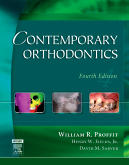|
|
|
| |
 |
|
|

|
 推薦指數:
推薦指數:





|
|
- 內容介紹
|
Contemporary Orthodontics, 4th Edition
By William R. Proffit, DDS, PhD, Henry W. Fields, Jr., DDS, MS, MSD and David M. Sarver, DMD, MS
768 pages 1805 ills
Trim size 8 1/2 X 10 7/8 in
Copyright 2007
Description
Now in full color, Contemporary Orthodontics, 4th Edition is a practical resource with a long tradition of excellence. Line drawings and more than 1,000 new color images illustrate concepts more clearly than ever. This book includes detailed information on diagnosis, treatment planning concepts, related problems or controversies, and current treatment procedures, including the role of orthodontics in comprehensive treatment of patients with multiple problems.
Key Features
A NEW full-color design includes a total of more than 1,400 clinical photographs and illustrations.
Application of the “soft tissue paradigm” to modern orthodontic diagnosis and treatment planning.
Critical evaluation of controversies in treatment approaches and treatment timing.
NEW information on the use of cone beam CT for 3-dimensional evaluation of dental and facial dimensions and relationships, and 3-D superimpositions to evaluate treatment response.
Problem-oriented treatment planning, with use of digital technology to develop a database that can feed through to the treatment plan.
Updated content on biomechanics to help you plan efficient use of modern orthodontic appliance systems.
NEW skeletal anchorage techniques using bone anchors and mini screws.
Chapters on adult treatment featuring the sequencing of multidisciplinary treatment, the new approach to lingual orthodontics, and a discussion of surgical vs. orthodontic treatment options.
New to this Edition
Full-color design includes hundreds of clinical photographs and illustrations with brighter, more engaging text and more demonstrative figures.
Diagnosis and treatment planning chapters are revised to consider new paradigms to teach students and orthodontists how to apply the results of current research to their practice and treatment plans.
Current technologies and advances in contemporary treatment provide clinicians with ways to make treatment planning and execution more efficient.
Updated content on biomechanics gives clinicians ways to plan appropriate orthodontic appliance systems through which mechanotherapy is delivered using principles of forces.
Updated information on mechanical devices, such as transplants, transpositions, implants, and temporary anchorage using mini screws, provide an understanding on how these devices can affect orthodontic treatment and what is available on the market to improve treatment outcomes.
Appliance chapters have been condensed to reflect only the most useful and contemporary materials.
Chapters on treatment for adults have been rewritten to include new concepts in periodontics and new clinical cases with predictions and outcomes and discussion of surgical vs. orthodontic treatment options.
Early treatment chapters have been consolidated and new research included in the reorganization of content to make it consistent with the best data available in the literature.
Every section of the book begins with a “section opener” to outline the main concepts discussed in that section.
Table of Contents
SECTION I. THE ORTHODONTIC PROBLEM
1. Malocclusion and Dentofacial Deformity in Contemporary Society
SECTION II. THE DEVELOPMENT OF ORTHODONTIC PROBLEMS
2. Concepts of Growth and Development
3. Early Stages of Development
4. Later Stages of Development
5. The Etiology of Orthodontic Problems
SECTION III. DIAGNOSIS AND TREATMENT PLANNING
6. Orthodontic Diagnosis: Development of Problem List
7. Orthodontic Treatment Planning: From Problem List to Specific Plan
8. Orthodontic Treatment Planning: Limitations, Controversies, and Special Problems
SECTION IV. BIOMECHANICS, MECHANICS AND CONTEMPORARY ORTHODONTIC APPLIANCES
9. The Biologic Basis of Orthodontic Therapy
10. Mechanical Principles in Orthodontic Force Control
11. Contemporary Orthodontic Appliances
SECTION V. TREATMENT IN PREADOLESCENT CHILDREN
12. Treatment of Nonskeletal Problems in Children
13. Treatment of Skeletal Problems in Children
SECTION VI. COMPREHENSIVE ORTHODONTIC TREATMENT IN THE EARLY PERMANENT DENTITION
14. The First Stage of Comprehensive Treatment: Alignment and Leveling
15. The Second Stage of Comprehensive Treatment: Correction of Molar Relationship and Space Closure
16. The Third Stage of Comprehensive Treatment: Finishing
17. Retention
SECTION VII. TREATMENT IN ADULTS
18. Special Considerations in Treatment for Adults
19. Combined Surgical and Orthodontic Treatment
|
|
|

